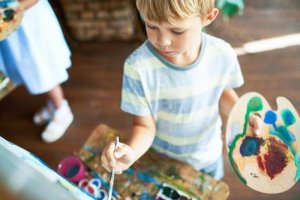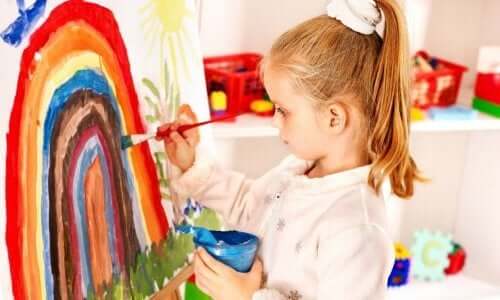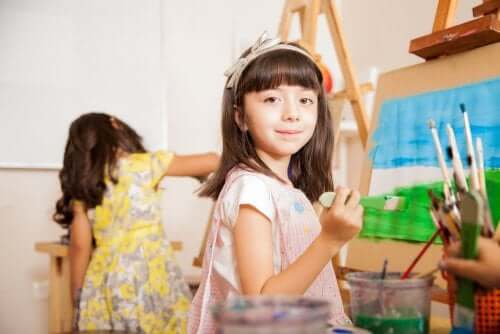The Benefits of Painting and Coloring


Written and verified by the psychologist María Alejandra Castro Arbeláez
For elementary students, painting and coloring are fundamental activities that enhance learning and creativity. Even though artistic education appears in most schools, it’s clear that it’s been losing important territory in recent years. Today, we’ll look at the benefits of painting and coloring in elementary school so that you can understand why we should pay more attention to it.
Painting and coloring involve filling a surface in with color. And this is what differentiates these activities from drawing. When children paint and color in, they express themselves through colors and open their imaginations to a world of possibilities.
The benefits of painting and coloring for children come not only from practicing art but also from learning about it. So, if the arts continue to lose importance in elementary schools, children will receive a less complete and ample education.
What are the benefits of painting and coloring in elementary school?
Imagination and creativity
Children can gather their experiences with the world and transform them as they create with colors. At the same time, they form new connections and relationships through their creative minds.
Their knowledge, memories and fantasies feed their imaginations. And painting allows children to explore and create their own creative and imaginative ideas through color.
Expression
When children paint and color, they express their feelings, emotions, and ideas. They can do so as a means of self-expression, or as a means of communicating with others.

As they color, for example, children can relive happy experiences that they’ve had recently or in the past. For example, they can use bright colors to portray their last birthday party or a family outing. They can also externalize feelings of sadness, making art a therapeutic exercise, using more somber colors.
Art in elementary school helps to develop visual thinking
Images encourage children to think about and understand the world in a visual way. In this sense, painting and coloring keep learning from being the simple acquisition of knowledge through words and numbers. Children develop visual thinking through color and, what’s more, art helps them to improve in other subjects.
The ability to observe
Painting and coloring in elementary school encourage children to observe the world around them more closely as they work. They see shapes, shadows, and different shades of color. As a result, this helps them to pay more attention to the details that surround them.
The development of observations skills through the creation of images facilitates the visual sensitivity of children towards the world.
Analytical skills and problem-solving
Painting allows children to explore and to put their ideas to the test. At the same time, they make decisions regarding how they choose to represent their ideas. For example, children learn to solve problems when they try to color and recreate a real 3-dimensional scene on a 2-dimensional paper.
The practice of coloring and painting in elementary schools allows children to develop concentration and be more persistent. And this is how they discover that art allows them to get closer to the sensations they’re trying to represent.
Art in elementary school boosts autonomy
The artwork that children create when they paint and color is theirs and theirs alone. Therefore, it holds special value for them and doesn’t require the judgment of others to be correct or incorrect. As a result, children learn that they possess the authority to say what the image is about and what it communicates. This increases their self-confidence and self-esteem.

Children have fun when they paint and color
Creating artwork carries all of the benefits that fun activities involve. Many times, we can observe children smiling as they paint and color. This is a sign that they’re learning something new and feel passionate about doing something healthy.
A creative education
By utilizing artistic activities like painting and coloring in education, we manage to develop abilities in children that would otherwise be forgotten. An education that’s creative is an education that’s complete… and that’s why we should be sure to encourage our children to color and paint.
As you can see, it’s extremely important for children to get the opportunity to paint and color throughout their elementary education. Not only should they enjoy art class, but educators should seek to incorporate the arts into every academic subject.
For elementary students, painting and coloring are fundamental activities that enhance learning and creativity. Even though artistic education appears in most schools, it’s clear that it’s been losing important territory in recent years. Today, we’ll look at the benefits of painting and coloring in elementary school so that you can understand why we should pay more attention to it.
Painting and coloring involve filling a surface in with color. And this is what differentiates these activities from drawing. When children paint and color in, they express themselves through colors and open their imaginations to a world of possibilities.
The benefits of painting and coloring for children come not only from practicing art but also from learning about it. So, if the arts continue to lose importance in elementary schools, children will receive a less complete and ample education.
What are the benefits of painting and coloring in elementary school?
Imagination and creativity
Children can gather their experiences with the world and transform them as they create with colors. At the same time, they form new connections and relationships through their creative minds.
Their knowledge, memories and fantasies feed their imaginations. And painting allows children to explore and create their own creative and imaginative ideas through color.
Expression
When children paint and color, they express their feelings, emotions, and ideas. They can do so as a means of self-expression, or as a means of communicating with others.

As they color, for example, children can relive happy experiences that they’ve had recently or in the past. For example, they can use bright colors to portray their last birthday party or a family outing. They can also externalize feelings of sadness, making art a therapeutic exercise, using more somber colors.
Art in elementary school helps to develop visual thinking
Images encourage children to think about and understand the world in a visual way. In this sense, painting and coloring keep learning from being the simple acquisition of knowledge through words and numbers. Children develop visual thinking through color and, what’s more, art helps them to improve in other subjects.
The ability to observe
Painting and coloring in elementary school encourage children to observe the world around them more closely as they work. They see shapes, shadows, and different shades of color. As a result, this helps them to pay more attention to the details that surround them.
The development of observations skills through the creation of images facilitates the visual sensitivity of children towards the world.
Analytical skills and problem-solving
Painting allows children to explore and to put their ideas to the test. At the same time, they make decisions regarding how they choose to represent their ideas. For example, children learn to solve problems when they try to color and recreate a real 3-dimensional scene on a 2-dimensional paper.
The practice of coloring and painting in elementary schools allows children to develop concentration and be more persistent. And this is how they discover that art allows them to get closer to the sensations they’re trying to represent.
Art in elementary school boosts autonomy
The artwork that children create when they paint and color is theirs and theirs alone. Therefore, it holds special value for them and doesn’t require the judgment of others to be correct or incorrect. As a result, children learn that they possess the authority to say what the image is about and what it communicates. This increases their self-confidence and self-esteem.

Children have fun when they paint and color
Creating artwork carries all of the benefits that fun activities involve. Many times, we can observe children smiling as they paint and color. This is a sign that they’re learning something new and feel passionate about doing something healthy.
A creative education
By utilizing artistic activities like painting and coloring in education, we manage to develop abilities in children that would otherwise be forgotten. An education that’s creative is an education that’s complete… and that’s why we should be sure to encourage our children to color and paint.
As you can see, it’s extremely important for children to get the opportunity to paint and color throughout their elementary education. Not only should they enjoy art class, but educators should seek to incorporate the arts into every academic subject.
All cited sources were thoroughly reviewed by our team to ensure their quality, reliability, currency, and validity. The bibliography of this article was considered reliable and of academic or scientific accuracy.
- Cándano, S. (2013). La pintura beneficiosa para el desarrollo de los niños. http://www.ampaikasbide.com/downloads/pintura/Desarrollo%20y%20aprendizaje.pdf
- Lopez, Z. V. (2011). La pintura como agente motivador para desarrollar la psicomotricidad en niños y niñas de primer año de educacion basica de la escuela fiscal 11 de noviembre de la ciudad de latacunga provincia de cotopaxi. latacunga provincia de cotopaxi.
- Salazar, R. (2011). La importancia de la creatividad y el arte.
- Vélez Luzardo, E. M. (2016). La pintura medio esencial para el desarrollo creativo en los niños de 2do. año de educación básica de la unidad educativa Clara Bruno de Piana (Bachelor’s thesis, Universidad de Guayaquil. Facultad de Comunicación Social. Carrera de Ingienería en Diseño Gráfico.). http://repositorio.ug.edu.ec/bitstream/redug/9729/1/TESIS%20EMAVELU%202016.pdf
- Villavicencio, Y. (2007). el desarrollo de la creatividad e imaginación a través de las técnicas grafoplásticas en la educación preescolar del liceo naval de manta en el periodo 2006-2007. Manta – Manabí – Ecuador.
This text is provided for informational purposes only and does not replace consultation with a professional. If in doubt, consult your specialist.








